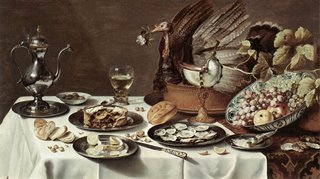

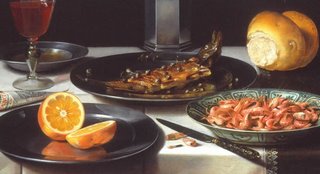
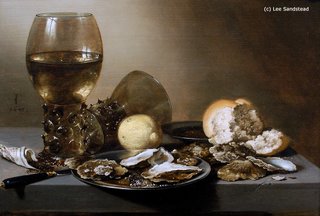
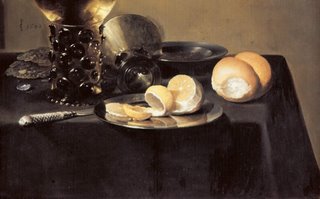
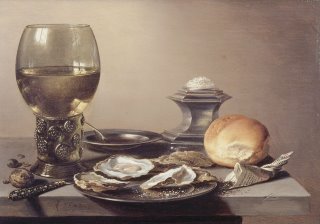
Sono stato a Lucca un paio di giorni. Di Lucca non ho visto nulla, come al solito, ma per fortuna è una città che avevo avuto l'occasione di visitare in precedenza. Però la stanza dell'hotel era piena di riproduzioni di quadri fiamminghi che mi hanno colpito molto.
Allora ho "intortato" un po' la concierge. Un po' perchè era una bella ragazza mora, un po' perchè è una regola d'oro in tutti i posti che visito, e un po' perchè mi interessava approfondire la faccenda dei quadri. Mi ha spiegato che erano riproduzioni di nature morte di un certo Pieter Claesz.
Allora ho fatto qualche ricerchina veloce, invece di piantarmi davanti alla pay-TV (no, non quella che pensate voi maligni, intendevo SKY). Ecco i risultati:
Pieter Claesz. was born in Germany. From about 1620, along with Willem Claesz, he developed the breakfast piece, a new genre of Dutch painting. Claesz.'s humble ingredients--bread, cheese, wine, a half-eaten herring, offered in pewter, glass, and porcelain tablewares--seldom varied. His still lifes were balanced, detailed, and tranquil. Unlike his predecessors, for whom the still life meant abundance and showing as much of the table as possible from a high viewpoint, Claesz. organized a single, graceful grouping on the table's corner with a simple, partly eaten meal or snack that bespoke human presence. Vanitas themes may be implicit in the unfinished meal, reminding the spectator of the transience and uncertainty of life. Claesz. and his generation also reduced color in their compositions, working in a low-key, almost monochrome palette that allowed them to concentrate on tonal relationships. A similar reductive tonalist aesthetic was taking place in contemporary landscape painting, which his son Nicolaes Berchem pursued. Claesz. founded a school of still life painting in Haarlem, where he lived from 1617.
I dipinti mi piacciono davvero molto. Enjoy.
BR/zespri

0 Comments:
Post a Comment
<< Home